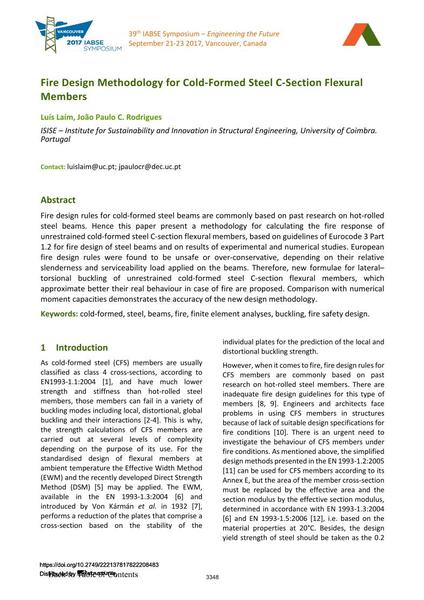Fire Design Methodology for Cold-Formed Steel C-Section Flexural Members

|
|
|||||||||||
Bibliografische Angaben
| Autor(en): |
Luís Laím
(ISISE – Institute for Sustainability and Innovation in Structural Engineering, University of Coimbra. Portugal)
João Paulo C. Rodrigues (ISISE – Institute for Sustainability and Innovation in Structural Engineering, University of Coimbra. Portugal) |
||||
|---|---|---|---|---|---|
| Medium: | Tagungsbeitrag | ||||
| Sprache(n): | Englisch | ||||
| Tagung: | IABSE Symposium: Engineering the Future, Vancouver, Canada, 21-23 September 2017 | ||||
| Veröffentlicht in: | IABSE Symposium Vancouver 2017 | ||||
|
|||||
| Seite(n): | 3348-3355 | ||||
| Anzahl der Seiten (im PDF): | 8 | ||||
| Jahr: | 2017 | ||||
| DOI: | 10.2749/222137817822208483 | ||||
| Abstrakt: |
Fire design rules for cold-formed steel beams are commonly based on past research on hot-rolled steel beams. Hence this paper present a methodology for calculating the fire response of unrestrained cold-formed steel C-section flexural members, based on guidelines of Eurocode 3 Part 1.2 for fire design of steel beams and on results of experimental and numerical studies. European fire design rules were found to be unsafe or over-conservative, depending on their relative slenderness and serviceability load applied on the beams. Therefore, new formulae for lateral– torsional buckling of unrestrained cold-formed steel C-section flexural members, which approximate better their real behaviour in case of fire are proposed. Comparison with numerical moment capacities demonstrates the accuracy of the new design methodology. |
||||
| Stichwörter: |
Stahl Finite-Elemente-Analysen Knicken Balken kaltverformt Brand
|
||||
